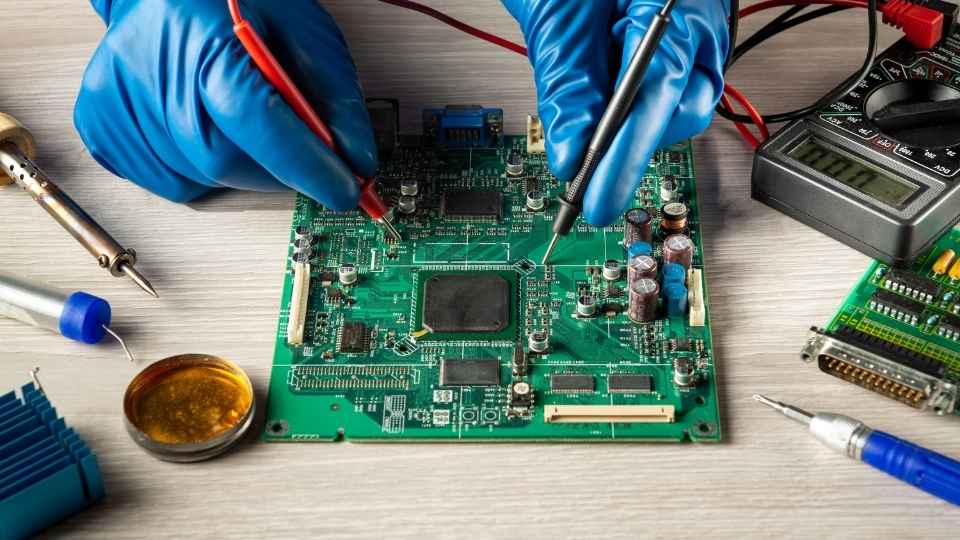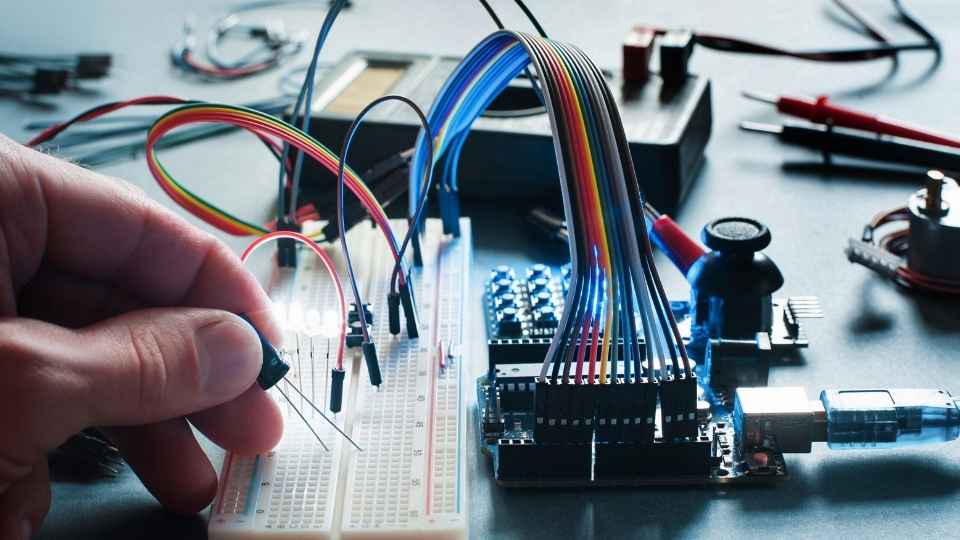
In the symphony of modern technology, where data flows like a river and information is currency, analog circuits stand as the guardians of signal amplification and processing. These intricate systems possess the power to breathe life into feeble whispers of electrical impulses, transforming them into robust waves capable of carrying vital information.
From the delicate dance of oscillators to the meticulous artistry of filters and feedback systems, analog circuits hold the key to unlocking a world brimming with possibilities.
Join us on this journey as we delve into the realm of analog circuitry, exploring its techniques, advancements, and innovations that empower signals to soar with freedom.
Key Takeaways
- Amplification is essential for increasing the strength of signals in analog circuits and allows for improved processing and accurate transmission of information.
- Oscillators play a crucial role in generating periodic waveforms used in various applications, and a thorough understanding of their principles and characteristics is important for effective design.
- Filters are indispensable in refining and enhancing the quality of signals in analog circuits by selectively allowing certain frequencies to pass through while attenuating others.
- Feedback loops provide stability and reduce distortion in analog circuits by compensating for variations in components, temperature, or power supply voltage, optimizing performance and ensuring reliable operation with minimal signal degradation.
Importance of Amplification in Analog Circuits
Amplification plays a crucial role in analog circuits as it increases the strength of signals, allowing for improved processing and accurate transmission of information. In analog circuits, signals are represented by continuous voltage or current levels, and amplification is necessary to boost these signals to desired levels for further processing. The process involves using electronic components such as transistors or operational amplifiers (op-amps) to increase the amplitude of the input signal without introducing significant distortion.
Amplification not only enhances weak signals but also allows for precise control over signal gain, enabling accurate manipulation and analysis of analog data. Understanding how to design and implement effective amplification strategies is essential in signal processing applications, particularly when it comes to understanding oscillator design in signal processing.
Oscillators generate periodic waveforms used in various applications like audio synthesis, radio transmission, or clock generation.
Understanding Oscillator Design in Signal Processing
To effectively design an oscillator for signal processing, it is crucial to have a thorough understanding of its principles and characteristics.

An oscillator is a circuit that generates a periodic waveform without an input signal. It plays a vital role in various applications, including communication systems, audio devices, and frequency synthesis.
The fundamental principle behind an oscillator is positive feedback, where the output signal is fed back to the input to sustain oscillation.
The characteristics of an oscillator are determined by factors such as its frequency stability, amplitude control, and phase noise performance.
Designing an oscillator involves selecting appropriate active devices like transistors or operational amplifiers and configuring passive components such as capacitors and inductors.
The Role of Filters in Signal Amplification and Processing
Filters play a critical role in refining and enhancing the quality of signals for various applications in signal processing. They are essential components in analog circuits that enable the manipulation, amplification, and shaping of signals. Filters are designed to selectively allow certain frequencies to pass through while attenuating others, thus improving the overall clarity and fidelity of the signal.
Depending on their specific characteristics, filters can be used to remove unwanted noise or interference from a signal, extract specific frequency bands, or modify the amplitude or phase response of a signal. This flexibility makes filters indispensable in numerous applications such as audio systems, telecommunications, radar systems, medical devices, and many more.
Common types of filters include:

- Low-pass filters that pass low-frequency components while attenuating higher frequencies
- High-pass filters that do the opposite
- Band-pass filters that allow only a specific range of frequencies to pass through
- Notch filters which suppress certain frequencies
Exploring Feedback Systems in Analog Circuitry
Exploring feedback systems in analog circuitry is crucial for understanding the benefits and stability they provide.
Feedback loops play a significant role in achieving desired performance characteristics, such as signal amplification and processing accuracy, while minimizing distortion and noise.
Feedback Loop Benefits
The utilization of feedback loops in analog circuits offers numerous advantages, such as improved stability and reduced distortion. This is achieved by feeding a portion of the output signal back to the input, which allows for precise control and regulation of the circuit's behavior.
Here are four key benefits of incorporating feedback loops into analog circuits:
Stability enhancement: Feedback loops help stabilize the circuit by automatically compensating for variations in components, temperature, or power supply voltage.
Distortion reduction: By continuously comparing the output with the desired input signal, feedback loops can correct any deviations and minimize distortion.
Increased bandwidth: Feedback amplifiers have wider frequency response due to their ability to compensate for changes in component characteristics.

Improved linearity: Feedback loops can linearize nonlinear elements within a circuit, resulting in more accurate amplification and processing.
Overall, feedback loops play a crucial role in optimizing analog circuits' performance and ensuring reliable operation with minimal signal degradation.
Stability in Circuits
Stability in circuits is a crucial aspect when designing and analyzing analog systems. It refers to the ability of a circuit to maintain its desired performance over time, despite variations in component values or external conditions. Achieving stability ensures reliable and accurate signal amplification and processing.
In analog circuits, stability is closely related to the concept of feedback. Feedback helps regulate the output by comparing it with the desired input, creating a closed-loop system that can compensate for changes or disturbances. Unstable circuits may exhibit oscillations or instability due to excessive positive feedback, leading to unpredictable behavior.
To ensure stability, engineers employ various techniques such as proper component selection, compensation methods like pole splitting or frequency compensation, and careful consideration of gain and phase margins. By addressing these factors accurately during circuit design, stability can be achieved while maintaining freedom for signal amplification and processing in analog systems.
Techniques for Signal Processing in Analog Circuits
Signal processing in analog circuits involves various techniques that enhance, manipulate, and extract valuable information from the input signals. These techniques play a crucial role in achieving accurate and reliable signal amplification and processing.
Here are four important techniques used in analog signal processing:

Filtering: This technique removes unwanted noise or frequency components from the input signal, allowing only the desired frequencies to pass through.
Modulation: Modulating the input signal enables it to be easily transmitted over long distances or transferred to different mediums.
Amplification: Analog circuits use amplifiers to increase the strength of weak signals without distorting their original waveform.
Demodulation: Demodulating the modulated signal helps recover the original information by extracting it from carrier waves.
These techniques form the foundation for advancements and innovations in analog signal amplification and processing, which have led to significant improvements in communication systems, audio equipment, and other applications.
In recent years, several advancements have been made in analog circuit design that allow for more efficient and precise signal amplification and processing. These include improved amplifier designs with higher gain bandwidth products, lower noise figures, and better linearity characteristics. Additionally, innovative digital-to-analog converters (DACs) with higher resolution and faster sampling rates have been developed, enabling more accurate conversion of digital signals into analog waveforms.
Overall, these advancements have paved the way for enhanced performance and functionality of analog circuits across various industries such as telecommunications, audio engineering, medical devices, and many others.

Advancements and Innovations in Analog Signal Amplification and Processing
Advancements in the design of analog circuitry have led to more efficient and precise amplification and processing of electrical signals. These innovations have revolutionized various industries that rely on analog signal amplification, such as telecommunications, audio systems, and medical devices.
One notable advancement is the development of high-gain operational amplifiers (op-amps) with low noise levels and wide bandwidths. These op-amps provide accurate amplification without introducing significant distortion or interference into the signal.
Additionally, improvements in transistor technology have resulted in faster switching speeds and lower power consumption, enabling higher performance analog circuits.
Furthermore, advancements in integrated circuit manufacturing techniques have allowed for the integration of multiple functions within a single chip, reducing component count and improving overall system efficiency.
Overall, these advancements have empowered engineers to design analog circuits that offer greater freedom in terms of performance, reliability, and flexibility.
Frequently Asked Questions
What Are Some Common Applications of Analog Signal Amplification and Processing?
Analog signal amplification and processing have numerous applications across various industries. These include audio amplification in music systems, sensor signal conditioning for industrial automation, and medical devices for amplifying physiological signals.
How Does Analog Signal Processing Differ From Digital Signal Processing?
Analog signal processing differs from digital signal processing in that it deals with continuous signals, while the latter handles discrete signals. It involves amplifying and manipulating analog signals using various circuits and components to achieve desired outcomes.

What Are the Main Challenges in Designing Analog Circuits for Signal Amplification?
Designing analog circuits for signal amplification poses several challenges. These include managing noise, maintaining linearity, achieving high gain, and ensuring stability. Precise component selection and careful circuit layout are critical to overcome these obstacles and achieve optimal performance.
Can Analog Signal Amplification and Processing Be Used in Wireless Communication Systems?
Analog signal amplification and processing play a crucial role in wireless communication systems, allowing for the transmission of information over long distances with minimal distortion. These techniques enable reliable and efficient communication in a variety of applications.
Are There Any Limitations to the Accuracy and Precision of Analog Signal Amplification and Processing Techniques?
The accuracy and precision of analog signal amplification and processing techniques can be limited by factors such as noise, distortion, and component tolerances. These limitations must be carefully considered in order to achieve desired performance in analog circuits.
 Basic Electronics ConceptsEssential ToolsCircuit Design BasicsMicrocontrollersDIY Electronics ProjectsRoboticsPrivacy PolicyTerms And Conditions
Basic Electronics ConceptsEssential ToolsCircuit Design BasicsMicrocontrollersDIY Electronics ProjectsRoboticsPrivacy PolicyTerms And Conditions
